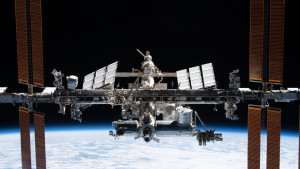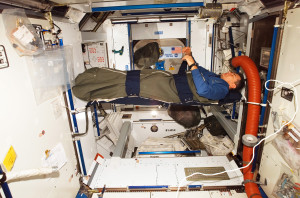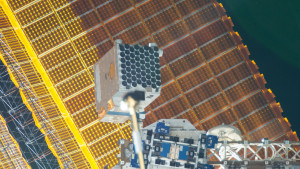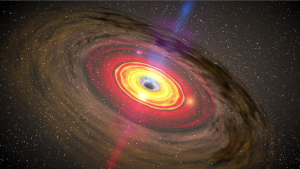Have you ever wondered what it’s like to live and work in space? To get the answer, you don’t have to look further than the International Space Station, the largest man-made object ever to orbit Earth! Stretching an impressive length greater than the size of an American football field, the ISS isn’t just a marvel of engineering – it’s a global scientific hub pushing the boundaries of human knowledge.
The constantly-crewed outpost is a beacon of international collaboration, with astronauts and cosmonauts from five space agencies living and working together on various research topics. But beyond its awe-inspiring size, the main goal of the ISS lies in its ability to unlock the secrets of the universe. Aboard this orbiting laboratory, groundbreaking research is conducted in fields ranging from medicine and biology to physics and materials science.
The discoveries made on the ISS not only push the frontiers of space exploration but also have a profound impact on our understanding of outer space. From growing plants in a microgravity environment to creating stronger, lighter materials, the ISS is a testament to the power of human ingenuity and collaboration. So, buckle up as we delve into the fascinating world of the International Space Station, exploring its history, the lives of its crew, and the groundbreaking research that’s shaping the future of space exploration and our world.

History of the International Space Station
The idea of a permanent human presence in space was born over time. The concept of a space station – a large, orbiting structure for astronauts to live and work in – emerged during the early days of space exploration (the early 1960s) as space agencies like NASA and the Soviet counterpart, ROSCOSMOS, began to dream beyond the confines of single-mission spacecraft. These discussions about a collaborative space station gained momentum in the following decades. With the fall of the Soviet Union in 1991, a unique opportunity for international cooperation presented itself.
Forging this global partnership had its challenges though. Merging different space agencies, and technical specifications for designing each component proved to be a big challenge in the history of space exploration. However, the potential rewards – a shared platform for scientific research and space exploration – outweighed the hurdles. By 1998, an official agreement was reached between the participating space agencies, paving the way for the construction of the ISS.
The International Space Station wasn’t built in a day nor was it built in a single mission. Due to its massive size and complexity, it was designed as a modular station, meaning it would be assembled piece by piece over numerous space missions. This modular approach allowed for flexibility in design and construction, enabling different space agencies to contribute their own modules. For more than a decade, starting in 1998, astronauts meticulously assembled the ISS in orbit, transforming it from a blueprint into the marvel of space exploration as it is seen today.
Life in Space: A Day on International Space Station
Imagine waking up to a breathtaking sunrise – not over a distant horizon, but across the entire curvature of the Earth. This is just another day for the astronauts and cosmonauts who call the International Space Station home.
The Training:
Living and working in this microgravity environment requires a unique blend of physical fitness, scientific expertise, and mental resilience. The crew selection process for the International Space Station is highly competitive. Aspiring astronauts and their counterparts from other space agencies like ROSCOSMOS, JAXA, CSA and ESA undergo rigorous physical and psychological evaluations to ensure they possess the technical skills, mental fortitude, and adaptability needed to thrive in space. Once selected, these international crew members embark on years of training, learning to operate the complex systems onboard the ISS, conduct scientific experiments, and work effectively in a multicultural team.
But what exactly does a typical day aboard the ISS look like? A typical day on the International Space Station follows a meticulously crafted schedule that balances scientific research with essential life support activities. Crew members wake up to a pre-set time adjusted for their orbit and begin their day with a rigorous exercise routine to combat the muscle and bone loss associated with microgravity. Microgravity, referred to as “weightlessness,” presents a significant challenge for astronauts. Without the constant pull of gravity, the body begins to adapt in ways that can impact vision, balance, and cardiovascular health. To counteract these effects, astronauts dedicate a significant portion of their day to specific exercises that mimic the effects of gravity on Earth.
Want to learn more about ‘how the space environment harms astronauts?’, consider reading: The negatives of Space Environment

Credits: ESA
Experiments on International Space Station:
Following their workout, the crew dives into the heart of their mission – scientific research. The ISS is a unique platform for conducting experiments in various fields, including plantation, medicine, biology, physics, and materials science. These experiments leverage the microgravity environment to unlock new discoveries that would be impossible to achieve on Earth. Imagine studying how crystals grow in the absence of gravity or how human cells react to long-duration spaceflight – these are just a few examples of the groundbreaking research conducted daily aboard the ISS.
Maintenance Tasks and Fun:
But science isn’t the only thing on the agenda. Astronauts also dedicate time to maintenance tasks, ensuring the smooth operation of the ISS’s complex life support systems. These systems are responsible for providing a breathable atmosphere, clean water, and managing waste – all crucial for sustaining human life in space. Mealtimes onboard the International Space Station are a social affair, offering a chance for crew members to connect and share a specially prepared space diet. In their limited free time, astronauts can enjoy stunning views of Earth from the cupola, catch up with loved ones back home through video calls, or simply relax and unwind from the demanding schedule of space life.
Key Instruments Onboard the International Space Station
While the International Space Station (ISS) boasts a diverse array of scientific instruments, some specialize in truly out-of-this-world research. NICER– Neutron Star Interior Composition Explorer and MAXI- Monitor of All-Sky X-ray Image onboard the International Space Station are some of these instruments that are dedicated to solving some of the amazing mysteries of the universe.
-
NICER’s Role on the International Space Station:
NICER isn’t your typical lab instrument. Launched in 2017, it resides on the exterior of the ISS, specifically attached to the ExPRESS Logistics Carrier (ELC). This strategic placement allows NICER to observe the universe without the obscuring effects of Earth’s atmosphere.
So how exactly does NICER study the universe?It’s all about X-rays. NICER is an X-ray timing and spectroscopy instrument, meaning it collects and analyzes X-ray emissions from these celestial objects. By precisely measuring the arrival times and energies of these X-rays, NICER can:
Measure the rotation rate of neutron stars-: As the hot surface of a neutron star rotates, it emits X-rays like a lighthouse beacon. NICER can detect these pulsations with incredible accuracy, providing insights into the star’s spin rate and internal structure.
Study the composition of neutron stars-: The specific energy of X-rays emitted by a neutron star can reveal clues about the elements present on its surface. NICER’s spectroscopy capabilities allow scientists to analyze the X-ray spectrum and determine the composition of the neutron star’s outer layers.
These are some of the many ways NICER contributes to space research.

Credits: NASA
- MAXI’s role on the International Space Station:
Launched in 2009, MAXI is a Japanese instrument mounted on the Kibo module of the ISS. It utilizes two key components:
Slit Cameras: These cameras have a narrow field of view but allow MAXI to capture X-rays from a wide swathe of the sky as the ISS orbits Earth.
X-ray Detectors: MAXI employs two types of detectors – a gas proportional counter for lower-energy X-rays and a solid-state X-ray CCD for higher-energy X-rays. These detectors convert X-ray photons into electronic signals for analysis.
Unlike our eyes that see visible light, MAXI observes the universe in the X-ray spectrum. This high-energy radiation is emitted by various celestial objects, including:Black holes:
As matter spirals into a black hole, it heats up and emits X-rays. By studying these X-rays, MAXI can help us understand the behaviour of these enigmatic objects.
Interested in black holes? Here is everything you need to know about black holes!
Neutron stars:
These incredibly dense remnants of massive stars also emit X-rays. MAXI’s observations can shed light on the properties and composition of neutron stars.
Stellar coronae:
The hot outer atmosphere of stars, called the corona, emits X-rays. Studying these X-rays with MAXI helps us understand stellar activity and processes like stellar flares.

Credits: NASA
One of MAXI’s key strengths is its ability to conduct an all-sky survey every 96 minutes, which coincides with one complete orbit of the ISS. This continuous monitoring allows scientists to detect transient X-ray events. These are short-lived bursts of X-ray radiation from objects like stellar flares or exploding stars (supernovae).
The future of the International Space Station
The International Space Station has served and collaborated for over two decades. But as we gaze towards the vast expanse of space, the question arises: what does the future hold for this orbiting marvel?
Currently, the ISS is in excellent operational health, conducting groundbreaking research and serving as a training ground for astronauts from around the globe. While its initial operational lifespan was slated for 2024, there are ongoing discussions about extending its operations potentially until 2030 or beyond.
The International Space Station, like all spacecrafts, has a finite lifespan. While discussions are ongoing regarding potential extensions, the current plan involves de-orbiting the station sometime in the 2030s. This process will be a complex undertaking, ensuring a controlled re-entry into Earth’s atmosphere where the station will disintegrate over the vast area of the Oceanic regions. The de-orbiting of the ISS will undoubtedly mark a significant moment in space history. However, its legacy will live on, not just in the scientific discoveries it facilitated, but also in the blueprint it provided for future space stations. The knowledge and experience gained from operating the ISS will be invaluable as we venture out for space exploration.
The Race for the Space Stations
The International Space Station has been a pit-stop of space habitation for over two decades. But as humanity sets its sights further into the cosmos, whispers of new space stations are starting to take shape.
While the ISS remains operational, several countries are developing their own space station concepts. China’s Tiangong space station program is already operational with its core module launched in 2021. This station is expected to expand in the coming years, eventually rivalling the size of the ISS. Russia, with its withdrawal from the ISS program, has also announced plans for a new space station called ROS (Russian Orbital Station), aiming for a 2028 launch. ISRO with its ambitious Indian Orbital Space Station also known as Bharatiya Antariksh Station (BAS) is all set to launch in the year 2035. These new International Space Stations represent a shift towards a more multipolar space landscape, potentially fostering international collaboration in the future.
Want to know about ISRO’s crewed mission in space exploration, consider reading this: ISRO’s crewed mission: Gaganyaan
The International Space Station stands as a testament to human ingenuity and the power of international collaboration. For over two decades, this orbiting marvel has served as a platform for groundbreaking scientific research, fostering a spirit of cooperation between nations and paving the way for a future filled with possibilities.
While the ISS may one day be decommissioned, its legacy will continue to inspire future generations. The knowledge gained from operating this complex outpost will prove invaluable as we venture further into the cosmos. Whether it serves as a training ground for deep-space missions or inspires the development of future space stations, the impact of the ISS will be felt for years to come. The future of space exploration is bright, and the lessons learned from the International Space Station will continue to guide us as we reach for the stars.
To know more about Space Travel and Exploration consider reading: Future of Space TravelLiked this, consider reading:
- Solar Flares: Dancing with Danger – 7 Facts About the Sun’s Wild Side
- 7 Mind-Blowing Black holes Discoveries: Redefining the Dark Kings of the Cosmos
- The Astonishing Summer Solstice of June 2024! – Stargazing Mumbai



